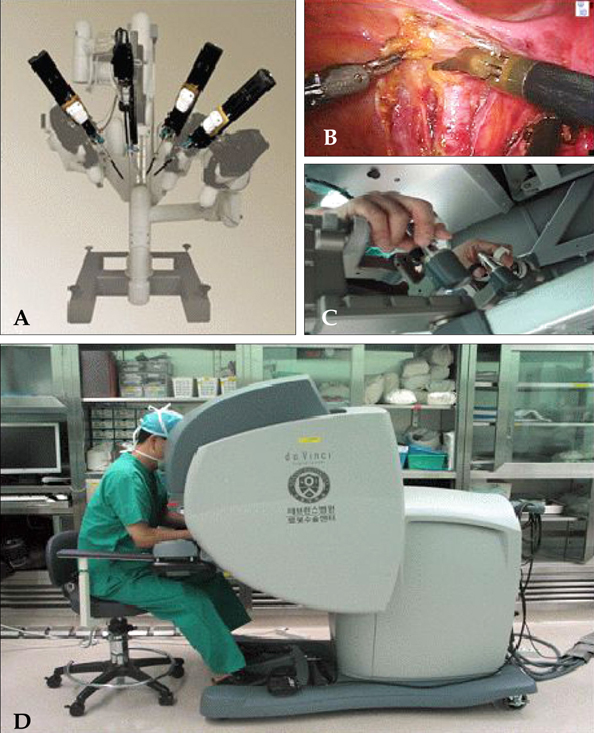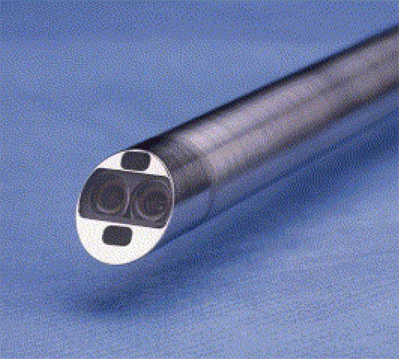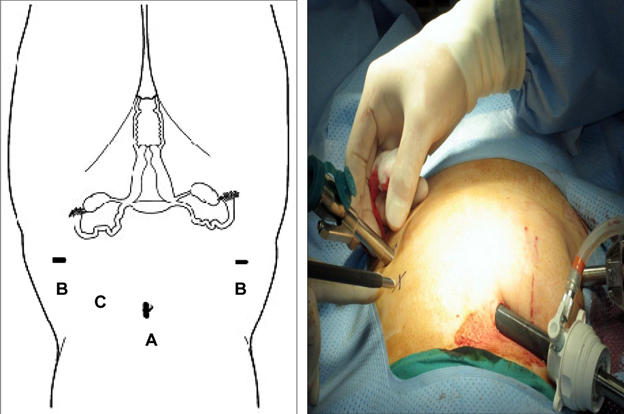Yonsei Med J.
2008 Dec;49(6):886-890. 10.3349/ymj.2008.49.6.886.
Robotic Surgery in Gynecologic Field
- Affiliations
-
- 1Department of Obstetrics and Gynecology, Women's Cancer Clinic, Yonsei University College of Medicine, Seoul, Korea. ytkchoi@yuhs.ac
- KMID: 1782934
- DOI: http://doi.org/10.3349/ymj.2008.49.6.886
Abstract
- Operative laparoscopy was initially developed in the field of gynecology earlier on and the advent of laparoscopic surgery led to advances in general surgery as well. In the last few years, a number of articles have been published on the performance of surgical procedures using the robot-assisted laparoscopy. The shortcomings of conventional laparoscopy have led to the development of robotic surgical system and future of telerobotic surgery is not far away, enabling a surgeon to operate at a distance from the operating table. The complete loss of tactile sensation is often quoted as a big disadvantage of working with robotic systems. Although the first generation da Vinci robotic surgical system provides improved imaging and instrumentation, the absence of tactile feedback and the high cost of the technology remain as limitations. New generations of the robotic surgical systems have been developed, allowing visualization of preoperative imaging during the operation. Though the introduction of robotics is very recent, the potential for robotics in several specialties is significant. However, the benefit to patients must be carefully evaluated and proven before this technology can become widely accepted in the gynecologic surgery.
Keyword
MeSH Terms
Figure
Cited by 1 articles
-
Efficacy and Safety of Robotic Procedures Performed Using the da Vinci Robotic Surgical System at a Single Institute in Korea: Experience with 10000 Cases
Dong Hoon Koh, Won Sik Jang, Jae Won Park, Won Sik Ham, Woong Kyu Han, Koon Ho Rha, Young Deuk Choi
Yonsei Med J. 2018;59(8):975-981. doi: 10.3349/ymj.2018.59.8.975.
Reference
-
1. Capek K, Capek J. Oxford MB, editor. The Insect Play. 1963. 1st ed. New York: Oxford University Press.2. Satava RM. Robotic surgery: from past to future-a personal journey. Surg Clin North Am. 2003. 83:1491–1500. xii.3. Bann S, Khan M, Hernandez J, Munz Y, Moorthy K, Datta V, et al. Robotics in surgery. J Am Coll Surg. 2003. 196:784–795.
Article4. Himpens J, Leman G, Cadiere GB. Telesurgical laparoscopic cholecystectomy. Surg Endosc. 1998. 12:1091.
Article5. Kang CM, Chi HS, Hyeung WJ, Kim KS, Choi JS, Lee WJ, et al. The first korean experience of telemanipulative robot-assisted laparoscopic cholecystectomy using the da vinci system. Yonsei Med J. 2007. 48:540–545.
Article6. Lee YS, Han WK, Oh YT, Choi YD, Yang SC, Rha KH. Robot-assisted laparoscopic radical prostatectomy: four cases. Yonsei Med J. 2007. 48:341–346.7. Farquhar CM, Steiner CA. Hysterectomy rates in the United States 1990-1997. Obstet Gynecol. 2002. 99:229–234.8. Wattiez A, Cohen SB, Selvaggi L. Laparoscopic hysterectomy. Curr Opin Obstet Gynecol. 2002. 14:417–422.9. Reich H. New techniques in advanced laparoscopic surgery. Baillieres Clin Obstet Gynaecol. 1989. 3:655–681.10. Falcone T, Goldberg J, Garcia-Ruiz A, Margossian H, Stevens L. Full robotic assistance for laparoscopic tubal anastomosis: a case report. J Laparoendosc Adv Surg Tech A. 1999. 9:107–113.
Article11. Falcone T, Goldberg JM. Robotics in gynecology. Surg Clin North Am. 2003. 83:1483–1489. xii.
Article12. Falcone T, Goldberg JM. Robotic surgery. Clin Obstet Gynecol. 2003. 46:37–43.13. Falcone T, Goldberg JM, Margossian H, Stevens L. Robotic-assisted laparoscopic microsurgical tubal anastomosis: a human pilot study. Fertil Steril. 2000. 73:1040–1042.
Article14. Donnez J, Nisolle M. Laparoscopic supracervical (subtotal) hysterectomy (LASH). J Gynecol Surg. 1993. 9:91–94.
Article15. Olive DL, Parker WH, Cooper JM, Levine RL. The AAGL classification system for laparoscopic hysterectomy. Classification committee of the American Association of Gynecologic Laparoscopists. J Am Assoc Gynecol Laparosc. 2000. 7:9–15.16. Semm K. [Hysterectomy via laparotomy or pelviscopy. A new CASH method without colpotomy]. Geburtshilfe und Frauenheilkunde. 1991. 51:996–1003.17. Morrison JE Jr, Jacobs VR. 437 classic intrafascial supracervical hysterectomies in 8 years. J Am Assoc Gynecol Laparosc. 2001. 8:558–567.
Article18. Diaz-Arrastia C, Jurnalov C, Gomez G, Townsend C Jr. Laparoscopic hysterectomy using a computer-enhanced surgical robot. Surg Endosc. 2002. 16:1271–1273.
Article19. Advincula AP, Falcone T. Laparoscopic robotic gynecologic surgery. Obstet Gynecol Clin North Am. 2004. 31:599–609. ix-x.
Article20. Fiorentino RP, Zepeda MA, Goldstein BH, John CR, Rettenmaier MA. Pilot study assessing robotic laparoscopic hysterectomy and patient outcomes. J Minim Invasive Gynecol. 2006. 13:60–63.
Article21. Kim YT, Kim SW, Yoon BS, Nahm EJ, Hur HW, Kim SH, et al. Robot-assisted total laparoscopic hysterectomy; initial experience in Korea. Korean J Obstet Gynecol. 2006. 49:2620–2625.22. Kim YT, Kim SW, Hyung WJ, Lee SJ, Nam EJ, Lee WJ. Robotic radical hysterectomy with pelvic lymphadenectomy for cervical carcinoma: a pilot study. Gynecol Oncol. 2008. 108:312–316.
Article
- Full Text Links
- Actions
-
Cited
- CITED
-
- Close
- Share
- Similar articles
-
- The impact of robotic surgery on gynecologic oncology
- Recent advances of robotic surgery and single port laparoscopy in gynecologic oncology
- Robotic lower pelvic port placement for optimal upper paraaortic lymph node dissection
- Totally Robotic Esophagectomy
- Current status of robotic surgery for pancreatic tumors




